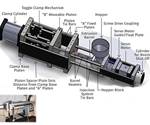Controlled Viscosity Molding Machine Adds Rotary Table
X2F says the addition of a rotary table to its machine reduces cycle times and opens up higher-volume production possibilities—up to four million parts per year.
X2F (Loveland, Colo.), which introduced a unique injection molding technology that leverages low pressure and a patented pulse-packing method to mold parts, has added a rotary table to its controlled viscosity machine. The company says the table will reduce cycle times and allow higher-volume production, including up to four million parts per year, depending on the cycle time. The machine targets the manufacture of critical components in electronics, automotive, industrial and medical industries.
X2F says the unique nature of its molding process allows it to successfully run materials and compounds that would be “unmoldable” in a standard injection process, with the controlled viscosity process reducing material degradation and molded-in stress that can occur in conventional molding. The process also allows for the use of greater amounts of fillers and additives than is currently possible.
X2F notes that its technology has found applications in optics and overmolded electronics. In automotive lighting applications, X2F says it can produce complex geometries, thicker lenses and larger shapes. In encapsulated electronics, the technology allows for new materials with advanced properties, fewer production steps, higher yields, and shorter cycle times. For filled resins, the process permits increased glass or carbon fiber loadings, even with a base material like polyetheretherketone (PEEK), dramatically improving strength and stiffness of the final product by 20%. The ability to run unique compounds results in molded parts with significant improvements in thermal conductivity, EMI shielding, and high-temperature resistance in electronics, for instance.

X2F says the new rotary table will allow the company to efficiently and economically serve its customers’ high-volume needs while delivering material properties not currently available at scale.
Photo Credit: X2F
Related Content
-
Optimizing Pack & Hold Times for Hot-Runner & Valve-Gated Molds
Using scientific procedures will help you put an end to all that time-consuming trial and error. Part 1 of 2.
-
Is There a More Accurate Means to Calculate Tonnage?
Molders have long used the projected area of the parts and runner to guesstimate how much tonnage is required to mold a part without flash, but there’s a more precise methodology.
-
Got Streaks or Black Specs? Here’s How to Find and Fix Them
Determining the source of streaking or contamination in your molded parts is a critical step in perfecting your purging procedures ultimately saving you time and money.












